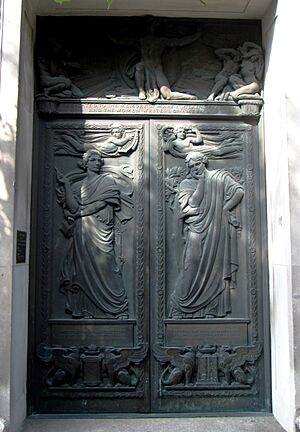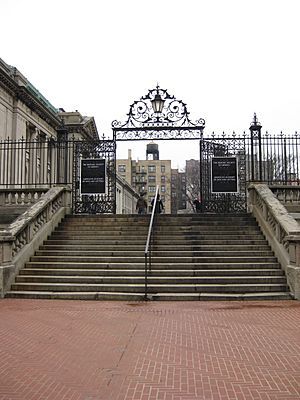American Academy of Arts and Letters facts for kids
The American Academy of Arts and Letters is a special group of 300 talented people. Their main goal is to "help, support, and keep alive" amazing work in writing, music, and art in America. Once chosen, members stay for life.
The Academy's main office is in New York City, in the Washington Heights area of Manhattan. It shares a beautiful complex called Audubon Terrace with other groups. This complex is known for its grand Beaux Arts style.
The Academy has galleries that are open to the public at certain times. They show art like paintings, sculptures, and photos by artists chosen by the members. They also display works by new members and people who have won awards. In 2014, a special exhibit opened, showing the recreated studio of composer Charles Ives.
The Academy's auditorium is famous for its excellent sound. Many musicians and engineers use it to record live music. Hundreds of commercial recordings have been made there.
Contents
History of the Academy
How it Started
The American Academy and Institute of Arts and Letters grew from three older groups. The first was the American Social Science Association, started in 1865 in Boston. This group created the National Institute of Arts and Letters (NIAL) in 1898. To join the NIAL, you had to be very good at art, music, or writing. At first, only 150 men could be members.
The third group was the American Academy of Arts, formed by the NIAL members in 1904. It was meant to be a top national arts group, like the famous French Academy.
The first seven members of the American Academy of Arts were chosen by the NIAL. They included famous writers like William Dean Howells and Samuel L. Clemens. Artists like Augustus Saint-Gaudens and John La Farge were also among them, along with musician Edward MacDowell. In 1904, the NIAL added a two-part system: 50 top members called "Academicians" and 200 "regular members." This system lasted for 72 years.
In 1908, the poet Julia Ward Howe became the first woman chosen for the Academy.
In 1976, the NIAL and the American Academy of Arts joined together. They became the American Academy and Institute of Arts and Letters. This combined group could have up to 250 living U.S. members. They also had up to 75 honorary members from other countries, but this stopped in 1993. In 1980, they started the annual Witter Bynner Poetry Prize to help young poets.
Special Government Recognition
The Academy has a special recognition from the U.S. government called a Congressional charter. This means it's one of the few "Title 36" organizations in the country. This special honor was given in 1916. It shows that the Academy is important to the nation, but it still works independently.
Important people like Senator Henry Cabot Lodge and former President Theodore Roosevelt helped make this happen. It took a few tries to get the charter approved. The Academy was first officially recognized in New York State in 1914, which led to the federal approval in 1916.
Academy Buildings

The Academy uses three buildings at the Audubon Terrace complex. This complex was built by Archer Milton Huntington, who was very wealthy and gave a lot of money to good causes. He helped convince the Academy and the National Institute of Arts and Letters to move there by giving them money for buildings.
The first building, on West 155th Street, was designed by William M. Kendall and opened in 1923. It's an administration building. Another building with an auditorium and gallery was designed by Cass Gilbert and built between 1928 and 1930. Both Kendall and Gilbert were Academy members.
In 2007, another group moved out of a building next to the Academy. This building became the Academy's Annex, giving them more gallery space. In 2009, a new entrance was built to connect the Annex to the main building.
Who Can Be a Member?
Members of the Academy are chosen for life. They include some of the most important artists, writers, and musicians in American history. These members also serve on committees that give out yearly awards to new artists.
Even though some members' names might not be well-known today, they were famous in their time. For example, William James once turned down his membership because his younger brother, Henry James, was chosen first!
For a long time, women were not chosen as members. But in January 1908, Julia Ward Howe (who was 88 years old) became the first woman member. In 1926, four more women were elected: Edith Wharton, Margaret Deland, Agnes Repplier, and Mary Eleanor Wilkins Freeman. This was seen as a big step forward for women in the Academy. In 1976, Gwendolyn Brooks became the first African-American woman to be elected.
Below is a partial list of past members:
- Henry Brooks Adams
- Herbert Adams
- Henry Mills Alden
- Nelson Algren
- Hannah Arendt
- Newton Arvin
- Wystan Hugh Auden
- Paul Wayland Bartlett
- Chester Beach
- Stephen Vincent Benét
- William Rose Benét
- Edwin Howland Blashfield
- William Brownell
- George de Forest Brush
- John Burroughs
- William S. Burroughs
- Nicholas Murray Butler
- George Washington Cable
- Hortense Calisher
- Joseph Campbell
- George Whitefield Chadwick
- William Merritt Chase
- Chou Wen-chung
- Timothy Cole
- Billy Collins
- Kenyon Cox
- John Dos Passos
- Bob Dylan
- Thomas Harlan Ellett
- Stanley Elkin
- Duke Ellington
- Ralph Ellison
- Daniel Chester French
- William Gaddis
- Hamlin Garland
- Charles Dana Gibson
- Cass Gilbert
- Richard Watson Gilder
- Basil Lanneau Gildersleeve
- Brendan Gill
- William Gillette
- Daniel Coit Gilman
- Allen Ginsberg
- Bertram G. Goodhue
- Robert Grant
- William Elliot Griffis
- Arthur Twining Hadley
- Childe Hassam
- Thomas Hastings
- Anthony Hecht
- David Jayne Hill
- Ripley Hitchcock
- Cecil de Blaquiere Howard
- Julia Ward Howe
- William Henry Howe
- William Dean Howells
- Archer Milton Huntington
- Charles Ives
- Henry James
- Robert Underwood Johnson
- Louis I. Kahn
- Kenneth Koch
- Maxine Kumin
- Sinclair Lewis
- Roy Lichtenstein
- Henry Cabot Lodge
- Abbott Lawrence Lowell
- Mary McCarthy
- Hamilton Wright Mabie
- Archibald MacLeish
- Frederick William MacMonnies
- J. D. McClatchy
- Brander Matthews
- William Keepers Maxwell Jr.
- William Rutherford Mead
- Gari Melchers
- Willard Metcalf
- Edna St. Vincent Millay
- Charles Moore
- Douglas Moore
- Paul Elmer More
- Robert Motherwell
- Georgia O'Keeffe
- Thomas N. Page
- Horatio Parker
- Joseph Pennell
- Bliss Perry
- William Lyon Phelps
- Charles Adams Platt
- Ezra Pound
- James Ford Rhodes
- James Whitcomb Riley
- George Lockhart Rives
- Elihu Root
- Theodore Roosevelt
- Mark Rothko
- Eero Saarinen
- Carl Sandburg
- John Singer Sargent
- Meyer Schapiro
- Arnold Schoenberg
- Harry Rowe Shelley
- Stuart Sherman
- Robert E. Sherwood
- Paul Shorey
- William Milligan Sloane
- Wallace Stevens
- Meryl Streep
- Lorado Taft
- Josef Tal
- Booth Tarkington
- Abbott Handerson Thayer
- William Roscoe Thayer
- Augustus Thomas
- Virgil Thomson
- Lionel Trilling
- Henry van Dyke
- John Charles Van Dyke
- Elihu Vedder
- Kurt Vonnegut
- Julian Alden Weir
- Barrett Wendell
- Edith Wharton
- Andrew Dickson White
- Thornton Wilder
- Brand Whitlock
- William Carlos Williams
- Woodrow Wilson
- Owen Wister
- George Edward Woodberry
- Frank Lloyd Wright
- James A. Wright
Academy Awards
The Academy gives out many awards to talented people. Most award winners are nominated by Academy members. However, for the Richard Rodgers awards, people can apply themselves.
Award for Distinguished Service to the Arts
This award is given to a U.S. resident who has "done great service to the arts." It includes a certificate and $1,000.
- 2003: Leon Botstein
- 2008: Judith Jamison
Other Special Awards
- Arts and Letters Award: These awards, now $10,000 each, are given every year. They go to artists, writers, composers, and architects to encourage their creative work.
- Marc Blitzstein Award: This $5,000 award helps composers, lyricists, or writers for musical theater and opera.
- Michael Braude Award for Light Verse: A $5,000 award given every two years for funny or light poems written in English.
- Arnold W. Brunner Memorial Prize: This $5,000 yearly prize goes to an architect from any country who has made important contributions to architecture as an art.
- Jimmy Ernst Award: This $5,000 award is given to a painter or sculptor who has shown a strong and dedicated artistic vision throughout their life.
- E. M. Forster Award: This $15,000 award helps young English writers visit the United States. It was created using money from the U.S. sales of E. M. Forster's novel Maurice.
- American Academy of Arts and Letters Gold Medals: Each year, gold medals are given for outstanding achievements in two different areas. These medals honor a person's entire body of work. Categories include:
- Writing (like essays and criticism) and Painting
- Biographies and Music
- Fiction (novels, short stories) and Sculpture
- History and Architecture
- Poetry and Music
- Drama and Graphic Art
- William Dean Howells Medal: This award is given every five years for the best American novel published during that time. It started in 1925.
- Charles Ives Prize: This prize helps young composers. Six scholarships of $7,500 and two fellowships of $15,000 are given each year. There's also the Charles Ives Living, which gives a promising American composer $75,000 a year for three years so they can focus only on music.
- Sue Kaufman Prize for First Fiction: This $5,000 prize is for the best first novel or collection of short stories published in the past year.
- Goddard Lieberson Fellowships: Two $15,000 fellowships are given yearly to young composers with amazing talent.
- American Academy of Arts and Letters Award of Merit: This award, a medal and $10,000, is given each year to an outstanding person in different fields like painting, short stories, sculpture, novels, poetry, and drama.
- Metcalf Awards: These awards, started in 1986, give $10,000 every two years to promising young writers and artists.
- Katherine Anne Porter Award: This $20,000 award is given every two years to a prose writer who has shown great skill and dedication to writing.
- Richard Rodgers Awards for Musical Theater: These awards help new musicals get produced in New York City. They are for composers and writers who are not yet well-known.
- Rome Prize in Literature: Each year, the Academy helps two young writers live and work for a year at the American Academy in Rome.
- Richard and Hinda Rosenthal Foundation Awards: Two awards of $5,000 each. One is for a great fiction book from the past year. The other is for a young painter who hasn't received much recognition yet.
- The Mildred and Harold Strauss Livings: These awards give two prose writers $50,000 a year for five years. This allows them to focus completely on their writing.
- Harold D. Vursell Memorial Award: This $10,000 award is given yearly to a writer whose recent prose is recognized for its excellent style.
- Morton Dauwen Zabel Award: This $10,000 award is given every two years to a poet, fiction writer, or critic who shows new and experimental ideas.
- Thornton Wilder Prize
See also
 In Spanish: Academia Estadounidense de las Artes y las Letras para niños
In Spanish: Academia Estadounidense de las Artes y las Letras para niños


